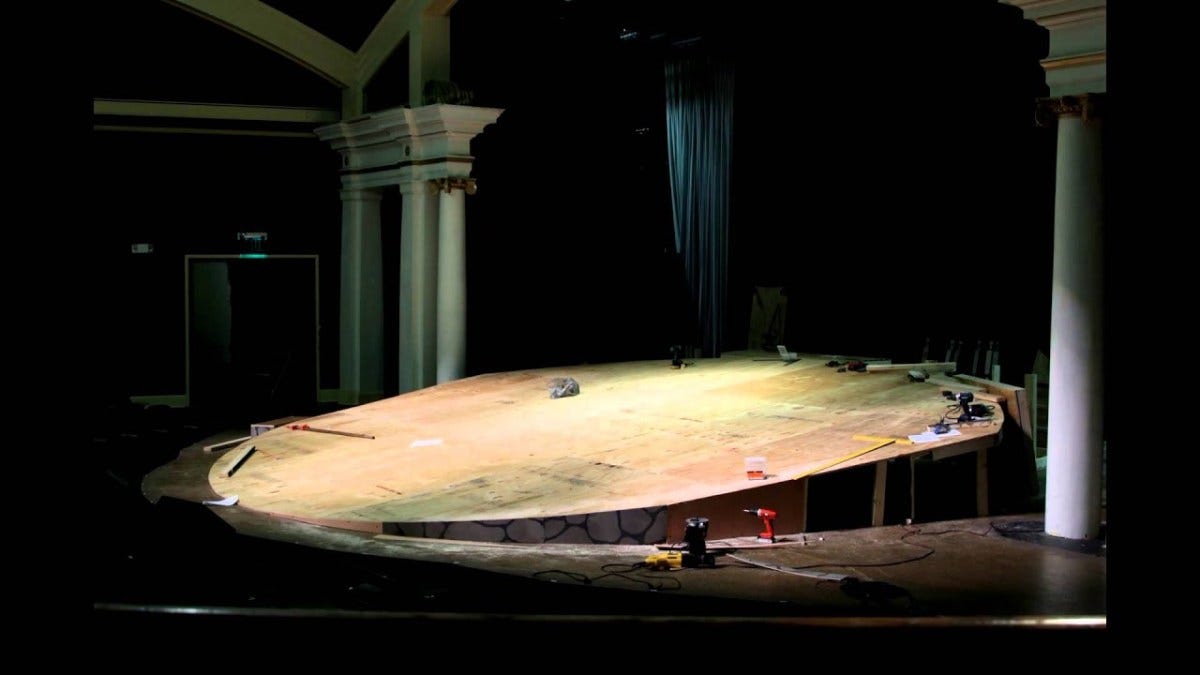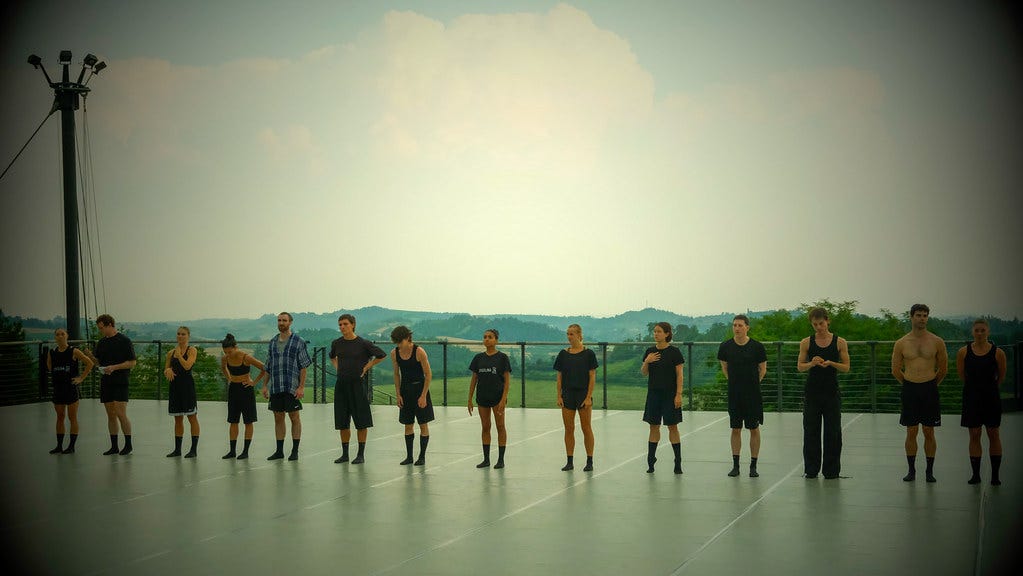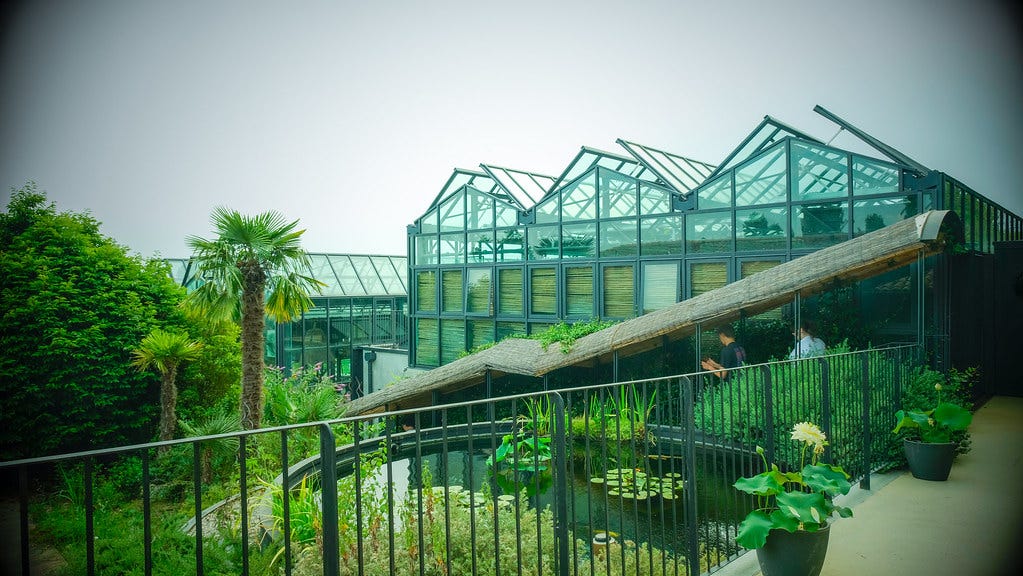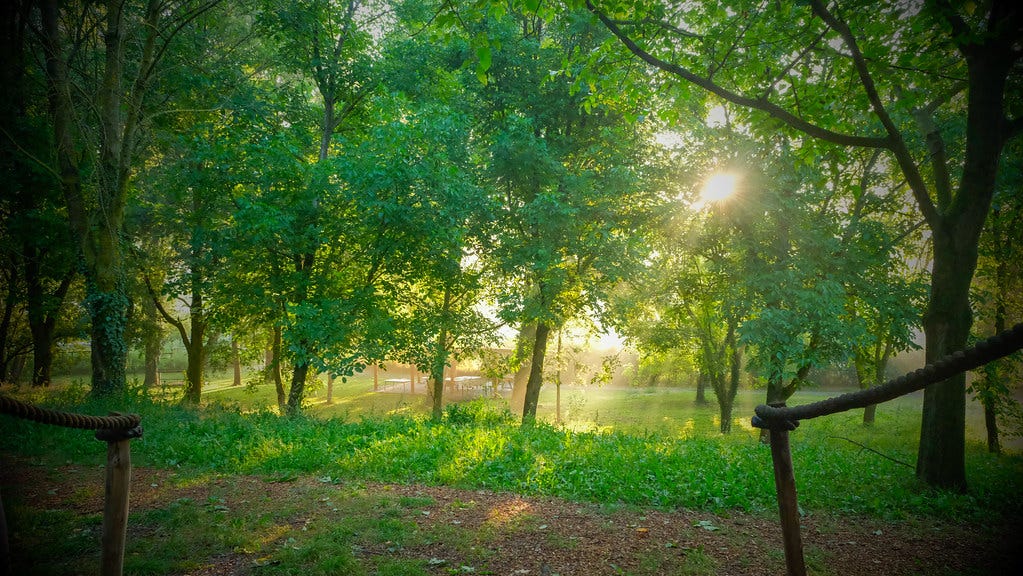I remember my first Theatre Studies & Drama class a a clueless 17-year-old, my Singaporean teacher introduced the world history of theatre, starting with the ancient Greek drama in an outdoor theatre in honour of Dionysus. Semi-circle seating was built on the slope of the hills around 700BC in the city-state of Athens. Theatron is what the seating area is called - meaning “viewing place”.
We might have talked about raked stage as well. So instead of building the seating area on sloped hills, you have the stage slightly slanted or sloped, so that the audience can have a better view. But terrible idea if you are dancing. Or on pointe. It didn’t occur to me then that the home to Shakespeare’s playing company, was also an open-air amphitheatre. We are so used to the comfort of our air-conditioned black box studios or magnificently lit theatres, that we forget the roofless days of old theatre.
[a raked stage from Google Image]
And it is not just the Anglo-Saxon world. Outdoor theatre has always been around. Street performances, Beijing opera, Ramlila is often performed outdoors. Japanese Noh Theatre can be performed outdoors too. There is something down to earth (quite literally) about outdoor theatres. Theatre is not just grand hallways with draped velvet and chandeliers. It is open to all. Lu Xun probably gave a better proletarian spin to this in his short story Village Opera, after he watched a Chinese opera from a boat in the Chinese equivalent of Venice.
[Modern re-enactment of the Village Opera / She Xi, probably AI-generated]
In fact, earlier in May I caught a performance by Singapore Ballet at the Singapore International Festival of Arts, along with live music and opera-singing, crafted for an outdoor setting in the heartlands. There was definitely something very visceral about watching the dancers lift and leap near you, especially in the tropical heat.
[Special mention of Singapore Ballet’s Pact of Water, featuring my violin teacher playing in the background]
That must be the reason why I was drawn to the Orsolina stage when I was doomscrolling during the Pandemic. I must have been following the Batsheva company on Instagram. The point was - I saw the open air stage, and told everyone who cared to listen that my dream would be to go there. The stage had no need for a cyclorama. It is probably up on a hill - it sits alongside the mountains and overlooks the expansive fields with cherries and grapes. If you stand on the stage, you probably get a panoramic view of the undulating mountains / hills.
[featuring Sydney Dance Co - on the open air stage]
Since then, I had gone down a rabbit hole of research, and found out where this place is (somewhere in Northern Italy), what programs they offer (plenty), and how I could possibly get there (send in an audition video etc., save up and sign up). Turned out Orsolina is not just a stage, it is also a dance school with summer intensives. Invited guests / choreographers / companies stay there and teach intensives. There are performances every week by touring dance companies who can do their residencies there. There were glamping tents for the students. Etc. etc. By the time this whole boring process led to a tangible result - i.e, an actual plane ticket and a confirmation e-mail a week before the program - I am in my late twenties, mostly desk-bound, scrambled to make time for dance classes or rehearsals.
The romanticism associated with an open air stage ( and the Italian countryside) was gravitational pull to me. But most people, my parents included, were probably baffled, especially since I am not a professional, have stopped teaching dance, and am probably going to be older than most attendees of the dance school. A week before my trip to Italy, I announced my plan to my parents who probably have not unfamiliar with the idea of “annual leave” nor “vacation”. But they understood that I had really wanted this, and my work life would sort itself out.
The arrival fallacy did not arrive when I first reached Orsolina. This was despite having sprained my ankle walking down wobbly wooden stairs, and despite hobbling up the steepest hill to get to the stage with nasty knee abrasions. When I sat down to watch the Gauthier Dance Company rehearse an Akram Khan choreography, I felt relieved. It was just as beautiful and expansive as promised, and the dancers looked performance-ready; they did not look like they were rehearsing.
It was eventually our turn on Day 3 to rehearse on the open air stage. We struggled through most of the choreography by the amazing Humanhood Company (which deserves another article on its own). Then the reality did sink in. The vinyl dance mat has turned into lava in the afternoon sun. It is perpetually sticky from being exposed to the elements. How the Sydney Dance people managed to do pirouette turns so effortlessly remains a myth to me. The fact that we are actually on top of a hill probably made it worse.
[The Greenhouse / Cafeteria / Swimming pool]
I found slight comfort in the fact that we were not the only ones struggling. The professionals from Sydney Dance were having quite an experience too. Halfway through a rather serious neoclassical piece, one of them broke into a grin / grimace as a fly or bee joined their pas de deux. On the day we are supposed to perform (spoiler alert, it did not happen as planned), another dancer was stung by a wasp as he was making his entrance from the stairs at the back during a rehearsal. Turned out some wasps were building their hive on the staircase. We are the ones causing them great inconvenience by making an entrance.
It is interesting that the open air experienced magnified what was missing in it, comparing to a traditional black box / theatre setting. It is also interesting to see how dance has adapted to modern theatres as much as the space as adapted to dance. The snippets of the Humanhood choreography online had dramatic lighting change which synced perfectly with the music and the movement. There were moments where dancers were snaking through the smoke, appearing in and out like a mirage. I felt a wave of goosebumps just watching it on a screen. There is no need to rig any lights for an open air theatre. But in a way, a pared down version without any set / tech, has its unique charm. What you see is what you get. While the audience might be occasionally distracted by the scenery, the focus is very much brought back to the movement, the intensity of it, the rawness of the emotions, with no curtains to hide from, no fourth wall to speak of.
The journey to exploring the outdoor needed to end on a dramatic note, or else I would not be writing this article. We had a week of tropical-level heat with the unforgiving sun beating down our necks. But of course, on the day of the performance, just 30 minutes before the show, a dark cloud loomed in the horizon. The absence of any lightning rod in our vicinity was alarming. And so we and our disgruntled audience members were herded by Mother Nature to the rehearsal studio.
The rehearsal studio at least provided a roof, but it could not have protected us against the power outage. The storms shook the cherry trees violently, drowned out any music we attempted to play, and led to a power failure across a few villages that even the locals have not seen in their lifetime. We finished the performance, in the most cramped stage for 50 something dancers, and with the audience clapping merrily and rapidly, even though one of the pieces we performed was titled “Void”.
[Right after our performance, the rain stopped. The sun wasn’t setting just yet]
A few weeks later, Paris experienced one of the heaviest storms too. A police car rolled through the flood, blasting the Titanic theme song. The tragicomedy of humans living and attempting to thrive with extreme weathers.
I felt surprisingly serene, even as my hiking shoes outside the tent became pails of water. The process of learning, unlearning, letting the movement seep and marinate in my body, had become so beautiful in itself, that the beauty of the stage was no longer the point. Not to mention the conversations and encounters I have had with fellow dancers, feeding off on their creative energy and insatiable curiosity for the world of movement. If anything, the romanticism of performing on the open stage lost its sheen somewhat. It is similar to any other performances with new stage / space to adapt to, with an audience who has made the effort to spectate, with adrenaline and cortisol and the elusive idea of perfection.
[Our last day! Electricity was still out, but the sun was in]
I could remember the soft breeze brushing against my skin, and some birds chirping, as we had our last company class on the open air stage. Our eyes were closed, our bodies relaxed under a gentler morning sun, our minds fixated not on shapes and forms, but on the energy of those around us. The most beautiful was not the stage, it was the most sincere concentration and dedication that each of us brought to this space. We were both observers and participants in its sanctity. In French, souvenir means not just the gift, but also means memory, a mental recollection that comes (“venir”) beneath (“sous”) the mind. I had the gift of rain from Italy; I had the gift of friendship with people I would not have otherwise met, and I could not ask for anything better.








